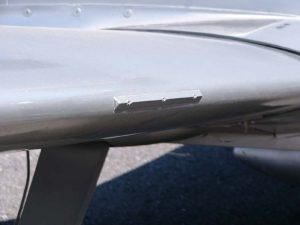
When inspecting the leading edge of an airplane’s wing, you may notice that it has small wedge-shaped strips. Known as stall strips, they change the wing’s aerodynamic properties. For a better understanding of stall strips and how they work, keep reading.
What Are Stall Strips?
Stall strips are small, angled strips of material that are affixed to the leading edge of an airplane’s wings. They’re designed to manipulate airflow over the wing so that stalls are less likely to occur.
Stalling is a phenomenon in which an airplane generates insufficient lift. The lift produced by the airplane isn’t enough to keep the aircraft in the air. Stalls can occur if the wing’s angle of attack is too high. As the angle of attack increases, so does the risk of stalling. Stall strips, however, protect against stalls.
How Stall Strips Work
Stall strips work by creating airflow turbulence. Some airplanes have a single stall strip per wing, whereas others have two or more stall strips per wing. Regardless, the stall strips perform the same task of creating turbulence.
With stall strips present, airflow over the wings will generate turbulence. The wings will then generate more lift in response to the turbulence, which can delay and prevent stalls from occurring.
How Stall Strips Are Installed
There are different types of stall strips. Some of them are installed in the factory. When an airplane is still being manufactured, the stall strips are added to the leading edges of its wings.
Other stall strips are sold in aftermarket kits. Engineers can add them to airplanes after the airplanes have already been manufactured. Whether factory-installed or aftermarket, all stall strips are installed on the leading edges of an airplane’s wings where they create airflow turbulence.
Stall Strips: An Important Safety Feature
Certain types of airplane certifications require the use of stall strips. This is because stall strips are an important safety feature.
With their ability to prevent stalls, stall strips promote a safer experience for pilots, crew members and passengers. Stalls are a dangerous situation that can result in a loss of control of the airplane. Stall strips help to delay the onset of a stall, giving the pilot more time to recover the airplane.
The bottom line is that stall strips are an important safety feature. They prevent stalls by disrupting airflow over the wings and creating a boundary layer of air.



